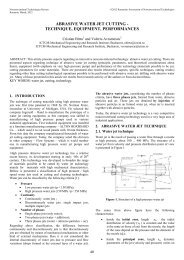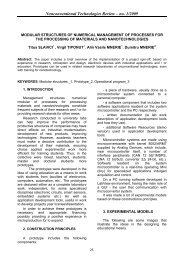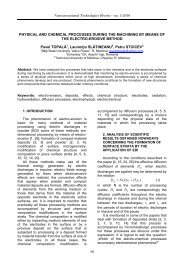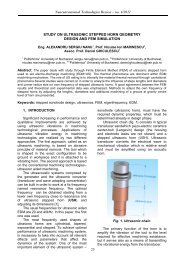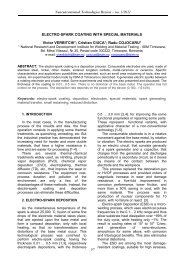modeling the plasma arc cutting process using ann - Revtn.ro
modeling the plasma arc cutting process using ann - Revtn.ro
modeling the plasma arc cutting process using ann - Revtn.ro
You also want an ePaper? Increase the reach of your titles
YUMPU automatically turns print PDFs into web optimized ePapers that Google loves.
Nonconventional Technologies Review – no. 4/2011<br />
high quality, highly p<strong>ro</strong>ductive cuts on a variety<br />
of different materials. Plasma <st<strong>ro</strong>ng>cutting</st<strong>ro</strong>ng> can be<br />
used to cut plate to 180 mm thick. Plasma<br />
<st<strong>ro</strong>ng>cutting</st<strong>ro</strong>ng> is less expensive than laser <st<strong>ro</strong>ng>cutting</st<strong>ro</strong>ng>.<br />
Nit<strong>ro</strong>gen based systems are well suited for high<br />
performance materials such as stainless steel,<br />
aluminum and nickel. Oxygen based systems<br />
are better for carbon steels and leave no nitride<br />
deposits, which complicate fur<st<strong>ro</strong>ng>the</st<strong>ro</strong>ng>r <st<strong>ro</strong>ng>p<strong>ro</strong>cess</st<strong>ro</strong>ng>ing.<br />
Plasma consumables can be short lived<br />
depending on gas selection, operator<br />
p<strong>ro</strong>ficiency and water selection. Heat affected<br />
zones appear in <st<strong>ro</strong>ng>the</st<strong>ro</strong>ng> area sur<strong>ro</strong>unding <st<strong>ro</strong>ng>the</st<strong>ro</strong>ng> cut.<br />
D<strong>ro</strong>ss can occur. Under water <st<strong>ro</strong>ng>cutting</st<strong>ro</strong>ng> helps<br />
reduce <st<strong>ro</strong>ng>the</st<strong>ro</strong>ng> size of <st<strong>ro</strong>ng>the</st<strong>ro</strong>ng> heat affected zone. Fine<br />
<st<strong>ro</strong>ng>plasma</st<strong>ro</strong>ng> <st<strong>ro</strong>ng>cutting</st<strong>ro</strong>ng> (high tolerance <st<strong>ro</strong>ng>plasma</st<strong>ro</strong>ng> <st<strong>ro</strong>ng>arc</st<strong>ro</strong>ng><br />
<st<strong>ro</strong>ng>cutting</st<strong>ro</strong>ng>) is used for <st<strong>ro</strong>ng>cutting</st<strong>ro</strong>ng> metals f<strong>ro</strong>m 5 to 10<br />
mm thickness. This system uses a nozzle with<br />
a smaller orifice diameter so <st<strong>ro</strong>ng>the</st<strong>ro</strong>ng> flow rate of <st<strong>ro</strong>ng>the</st<strong>ro</strong>ng><br />
spinning <st<strong>ro</strong>ng>plasma</st<strong>ro</strong>ng> gas is much higher. The cut<br />
quality is nearly as good as laser <st<strong>ro</strong>ng>cutting</st<strong>ro</strong>ng>, but at<br />
a lower cost.<br />
2. ARTIFICIAL NEURAL NETWORKS:<br />
AN OVERVIEW<br />
The appearance of ANNs is related to <st<strong>ro</strong>ng>the</st<strong>ro</strong>ng><br />
attempt to form an artificial system based on<br />
ma<st<strong>ro</strong>ng>the</st<strong>ro</strong>ng>matical models which will be, in its<br />
structure, function and information (signal)<br />
<st<strong>ro</strong>ng>p<strong>ro</strong>cess</st<strong>ro</strong>ng>ing, similar to biological nervous<br />
systems, and thus be able to <st<strong>ro</strong>ng>p<strong>ro</strong>cess</st<strong>ro</strong>ng><br />
“intelligently” information (signals), that is,<br />
simulate biological intelligence [2].<br />
ANNs consist of a larger number of<br />
neu<strong>ro</strong>ns (as basic <st<strong>ro</strong>ng>p<strong>ro</strong>cess</st<strong>ro</strong>ng>ing units) distributed<br />
in several layers. Each ANN usually have three<br />
layers: input layer, hidden layer, and output<br />
layer. The greatest number of ANNs used for<br />
<st<strong>ro</strong>ng>modeling</st<strong>ro</strong>ng> machining <st<strong>ro</strong>ng>p<strong>ro</strong>cess</st<strong>ro</strong>ng>es have one or<br />
two hidden layers though <st<strong>ro</strong>ng>the</st<strong>ro</strong>ng>re may be more of<br />
<st<strong>ro</strong>ng>the</st<strong>ro</strong>ng>m. Neu<strong>ro</strong>ns of one layer are connected by<br />
specific synapses to <st<strong>ro</strong>ng>the</st<strong>ro</strong>ng> neu<strong>ro</strong>ns of <st<strong>ro</strong>ng>the</st<strong>ro</strong>ng>ir<br />
neighboring layers. Apart f<strong>ro</strong>m specific types of<br />
ANNs, <st<strong>ro</strong>ng>the</st<strong>ro</strong>ng>re are no interconnections between<br />
<st<strong>ro</strong>ng>the</st<strong>ro</strong>ng> neu<strong>ro</strong>ns belonging to <st<strong>ro</strong>ng>the</st<strong>ro</strong>ng> same layer. The<br />
interconnections between particular neu<strong>ro</strong>ns by<br />
<st<strong>ro</strong>ng>the</st<strong>ro</strong>ng> layers are characterized by weights, which<br />
change during <st<strong>ro</strong>ng>the</st<strong>ro</strong>ng> ANN training. By tuning a<br />
set of weights and biases in <st<strong>ro</strong>ng>the</st<strong>ro</strong>ng> training<br />
<st<strong>ro</strong>ng>p<strong>ro</strong>cess</st<strong>ro</strong>ng>, ANN learns <st<strong>ro</strong>ng>the</st<strong>ro</strong>ng> relationship between<br />
given inputs and related outputs.<br />
The ANN based <st<strong>ro</strong>ng>modeling</st<strong>ro</strong>ng> is not a straightforward<br />
<st<strong>ro</strong>ng>p<strong>ro</strong>cess</st<strong>ro</strong>ng> and nume<strong>ro</strong>us decisions<br />
related to ANN <st<strong>ro</strong>ng>arc</st<strong>ro</strong>ng>hitecture and training<br />
<st<strong>ro</strong>ng>p<strong>ro</strong>cess</st<strong>ro</strong>ng>es have to be made. The methodology<br />
and basic steps in ANN <st<strong>ro</strong>ng>modeling</st<strong>ro</strong>ng> of machining<br />
<st<strong>ro</strong>ng>p<strong>ro</strong>cess</st<strong>ro</strong>ng>es and derivation of ma<st<strong>ro</strong>ng>the</st<strong>ro</strong>ng>matical<br />
equations f<strong>ro</strong>m ANNs is presented in [3,4].<br />
After selecting <st<strong>ro</strong>ng>the</st<strong>ro</strong>ng> ANN <st<strong>ro</strong>ng>arc</st<strong>ro</strong>ng>hitecture and<br />
adopting <st<strong>ro</strong>ng>the</st<strong>ro</strong>ng> ANN with <st<strong>ro</strong>ng>the</st<strong>ro</strong>ng> best performance<br />
achieved during training and testing, created<br />
ANN may be used for simulation, prediction or<br />
can be used as a objective function for<br />
optimization.<br />
3. MODELING THE PAC PROCESS<br />
The objective of <st<strong>ro</strong>ng>the</st<strong>ro</strong>ng> <st<strong>ro</strong>ng>plasma</st<strong>ro</strong>ng> <st<strong>ro</strong>ng>arc</st<strong>ro</strong>ng> <st<strong>ro</strong>ng>cutting</st<strong>ro</strong>ng><br />
(PAC) <st<strong>ro</strong>ng>p<strong>ro</strong>cess</st<strong>ro</strong>ng> is to concentrate a large<br />
amount of energy on a small surface of a<br />
workpiece which leads to intensive heating of<br />
<st<strong>ro</strong>ng>the</st<strong>ro</strong>ng> material surface. The source of energy is<br />
high temperature and high speed ionised gas.<br />
The gas is ionised <st<strong>ro</strong>ng>using</st<strong>ro</strong>ng> a direct current<br />
passing between <st<strong>ro</strong>ng>the</st<strong>ro</strong>ng> cathode (inside <st<strong>ro</strong>ng>the</st<strong>ro</strong>ng><br />
nozzle) and anode (workpiece). The <st<strong>ro</strong>ng>plasma</st<strong>ro</strong>ng> jet<br />
cuts <st<strong>ro</strong>ng>the</st<strong>ro</strong>ng> material by releasing <st<strong>ro</strong>ng>the</st<strong>ro</strong>ng> energy spent<br />
for <st<strong>ro</strong>ng>the</st<strong>ro</strong>ng> <st<strong>ro</strong>ng>plasma</st<strong>ro</strong>ng> gas ionisation upon hitting <st<strong>ro</strong>ng>the</st<strong>ro</strong>ng><br />
workpiece surface. The removal of <st<strong>ro</strong>ng>the</st<strong>ro</strong>ng> melted<br />
material f<strong>ro</strong>m <st<strong>ro</strong>ng>the</st<strong>ro</strong>ng> <st<strong>ro</strong>ng>cutting</st<strong>ro</strong>ng> zone is done by <st<strong>ro</strong>ng>the</st<strong>ro</strong>ng><br />
action of <st<strong>ro</strong>ng>plasma</st<strong>ro</strong>ng> jet kinetic energy. The<br />
characteristics of <st<strong>ro</strong>ng>plasma</st<strong>ro</strong>ng> jet can be<br />
significantly altered by changing <st<strong>ro</strong>ng>the</st<strong>ro</strong>ng> type of<br />
gas, gas flow, <st<strong>ro</strong>ng>cutting</st<strong>ro</strong>ng> current, and nozzle size,<br />
etc.<br />
Even though it is <st<strong>ro</strong>ng>the</st<strong>ro</strong>ng> case of a complex<br />
<st<strong>ro</strong>ng>p<strong>ro</strong>cess</st<strong>ro</strong>ng>, which is characterized by a large<br />
number of influential factors, <st<strong>ro</strong>ng>the</st<strong>ro</strong>ng> previous<br />
analysis has shown that this number can be<br />
reduced to three main influential factors: <st<strong>ro</strong>ng>cutting</st<strong>ro</strong>ng><br />
current (I), <st<strong>ro</strong>ng>cutting</st<strong>ro</strong>ng> speed (V), and plate<br />
thickness (s). Influential factors were varied on<br />
a great number of levels. The ten-point height<br />
of irregularities (R z ), which is one of <st<strong>ro</strong>ng>the</st<strong>ro</strong>ng> basic<br />
characteristics of <st<strong>ro</strong>ng>the</st<strong>ro</strong>ng> surface quality, was<br />
selected as <st<strong>ro</strong>ng>the</st<strong>ro</strong>ng> target function (output value).<br />
The experiment was described in more detail in<br />
[1] and experimental data are given in Table 1.<br />
44



